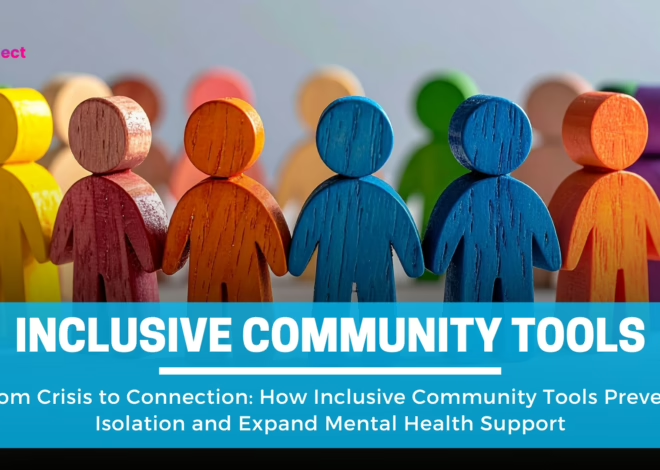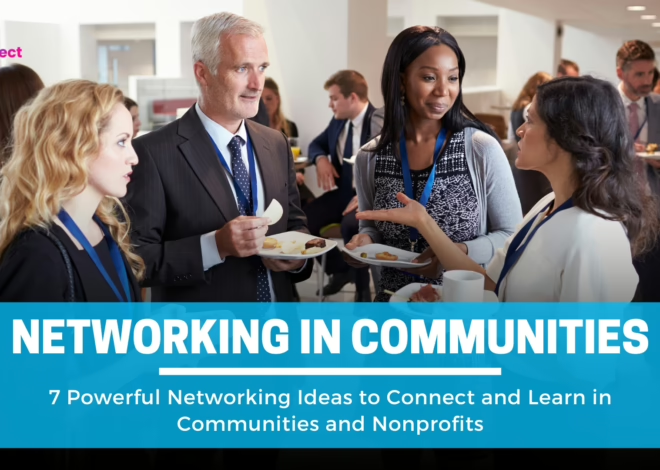
What is Product Led Growth? 6 Inspiring Examples to Learn From
Table of Contents
In a world where users expect value upfront and have little patience for clunky onboarding or pushy sales calls, a new way of growing businesses has emerged. It’s efficient, cost-effective, and scalable and it all starts with one question: What if your product could do the selling for you?
Welcome to the era of Product Led Growth.
Smart Summary: Here’s what this blog on Product Led Growth will explore
Why Product Led Growth is Worth Paying Attention
Product Led Growth (PLG) is transforming how organizations scale, by letting the product do the talking. When users can experience value quickly, growth follows naturally. PLG reduces dependency on large sales teams and marketing budgets.
What is Product Led Growth?
Product Led Growth is a go-to-market strategy where user acquisition, retention, and expansion are all driven by the product itself. Think free trials, freemium access, intuitive design, and instant value, so users become customers without pressure.
- Slack: Slack’s PLG success came from seamless onboarding and viral team invites. One person signs up, and the whole team joins. The product’s value grows with every new user, no sales pitch required.
- Dropbox: Dropbox famously used a PLG-friendly referral loop, get free storage for inviting friends. It turned every user into a marketer, proving that product utility and rewards can be more powerful than ads.
- Calendly: Calendly embedded growth into its product. Every shared scheduling link introduced someone new to the platform, turning everyday usage into effortless outreach.
- Canva: Canva made design accessible to everyone. Its drag-and-drop simplicity and free tier created millions of advocates who started free and stuck around to pay.
- Figma: Figma revolutionized design collaboration by enabling real-time teamwork in the browser. Its freemium model made it easy for teams to try and then scale usage organically.
- Kannect: Kannect is redefining PLG in mission-driven spaces. It offers nonprofits, universities, and communities a full-featured platform for free with messaging, campaigns, donations, events, and more. The product is designed to be self-serve and intuitive, helping teams grow impact effortlessly.
Common Traits of Great Product Led Growth Companies
• User-focused design: intuitive experiences that deliver value fast
• Data-driven decisions: refining the product based on real usage
• Community engagement: users helping users, fueling growth
• Transparent value propositions: clear pricing and honest upgrade paths
The Benefits of Product Led Growth
PLG boosts adoption, lowers customer acquisition costs, shortens onboarding time, and improves retention. It puts power in the hands of users and scales more sustainably.
Why Community is the Secret Weapon in Product Led Growth
Communities offer support, drive learning, and build trust. A vibrant community transforms users into advocates, amplifying product reach far beyond traditional marketing.
Product Led Growth Isn’t Just for Startups
PLG strategies now power companies of all sizes, from scrappy startups to global platforms. When the product delivers immediate value, size doesn’t matter, impact does.
Kannect Empowers That Vision of Product Led Growth
Kannect is built from the ground up with PLG in mind. From self-serve onboarding to mobile-first access, it empowers organizations to build, engage, and grow; no training, no friction, just real results.
Why Product Led Growth is Worth Paying Attention
The way people discover, try, and stick with software has changed forever. Modern buyers prefer to experience a product before they buy. They want to test, explore, and validate its usefulness, on their own terms. This behavioral shift has given rise to a go-to-market strategy that puts the product front and center, removing friction and allowing users to get value instantly.
That strategy? Product Led Growth.
From tools you use every day like Zoom or Slack, to breakout SaaS startups, Product Led Growth is becoming the go-to strategy for building businesses that grow fast without bloated marketing budgets or massive sales teams.
In today’s hyper-competitive market, attention spans are short and expectations are high. If a product doesn’t solve a real problem within minutes of trying it, users move on. That’s why more companies are embracing Product Led Growth, because it flips the old script.
Instead of relying heavily on cold emails, gated demos, or long sales cycles, PLG businesses focus on building a great experience from the first click. When users can sign up, see value quickly, and invite others to join organically, the product itself becomes the engine of acquisition, retention, and expansion.
What is Product Led Growth?
Product Led Growth (PLG) is a business strategy where the product itself drives customer acquisition, expansion, and retention. Instead of relying on aggressive sales tactics, companies let users experience value firsthand, often through freemium models or self-serve trials so the product becomes its own best marketing and sales tool.
At its core, Product Led Growth flips the traditional sales funnel. Rather than front-loading investment in sales development or paid marketing, businesses invest in building a product so useful and intuitive that it sells itself. Whether it’s onboarding, upselling, or scaling, the product takes the lead. This approach not only shortens time-to-value but also attracts more qualified users, because they’ve already validated the product’s relevance by using it.
In Product Led Growth, users discover the product, get quick wins, and grow into paying customers as their needs expand. The experience often starts with minimal commitment; a free trial, limited free plan, or hands-on demo environment, which gives users immediate utility. Once trust is built and value is felt, conversion becomes a natural next step. This is how platforms like Dropbox, Slack, and Notion scaled rapidly with the product as the centerpiece of growth, not the sales team.
Importantly, Product Led Growth work particularly well in today’s digital landscape where buyers conduct their own research, value autonomy, and expect instant gratification. They don’t want to “talk to sales”, they want to try before they buy.
So, why focus on product led growth? Because it puts the user in control, removes friction from the buying process, and builds trust faster. It reduces acquisition costs, shortens the sales cycle, and improves retention, making it a powerful model for companies that want to scale with leaner teams and stronger community engagement.
When done right, Product Led Growth doesn’t just bring in users; it creates fans, advocates, and network effects that power sustainable, long-term growth.
In this blog, we’ll explore what product led growth is all about, break down the key traits of successful PLG companies, explore 6 inspiring examples, and show you how even platforms like Kannect are tapping into the same mindset to deliver smarter, more sustainable, and user-led growth.
1. Slack: Viral Team Adoption Leading to Product Led Growth
Slack made team communication so easy and intuitive that teams started inviting other teams. Users could sign up instantly, create channels, and start collaborating, no IT help needed.
Key PLG Moves:
- Instant freemium access
- Clear UX that required zero training
- Virality baked into team invites
Slack didn’t grow by telling people it was better than email, it showed them.
But what truly sets Slack apart is its origin story: An accidental innovation that became a blueprint for product led growth success. Slack’s journey began not as a communication platform, but as a side project inside a gaming company called Tiny Speck. While developing an online game called Glitch, the team built an internal tool to streamline communication. The game didn’t succeed, but the tool did. Recognizing the tool’s potential, they pivoted and Slack was officially launched in 2013.
What followed was rapid, organic growth. With a freemium model at its core, Slack empowered teams to start using the product instantly and without friction. This ease of entry sparked widespread adoption, as users invited their colleagues and teams expanded naturally. Its intuitive design eliminated the need for training, while deep integration capabilities allowed it to slot seamlessly into existing workflows, from Google Drive to Zoom to Asana.
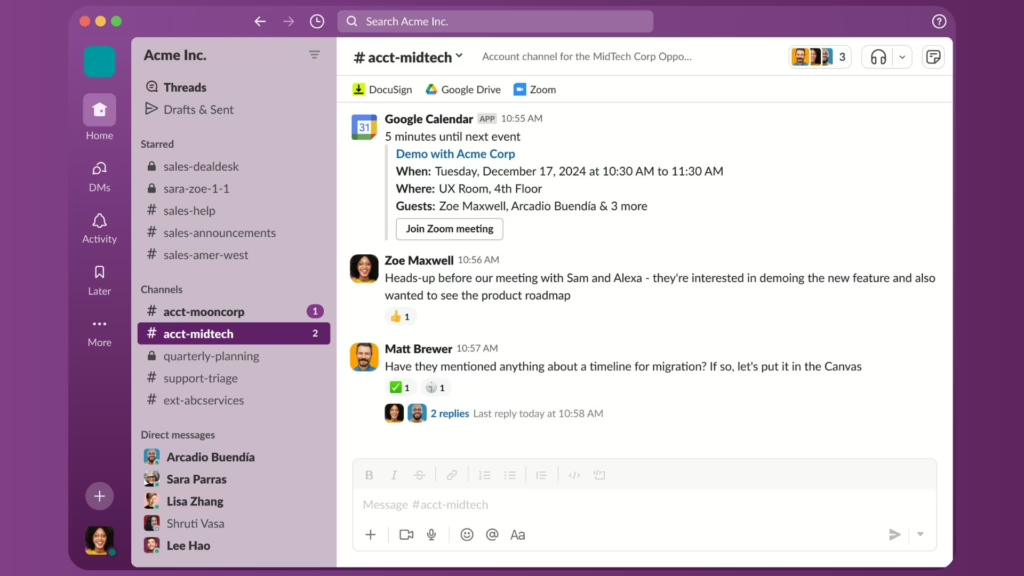
What makes Slack stand out as a champion of Product Led Growth:
- Freemium model: Allowed teams to get started without any financial commitment, removing a major barrier to adoption.
- User-centric design: Prioritized ease of use and quick onboarding, making it easy for teams to get value on day one.
- Integration capabilities: Enabled users to connect their favorite tools, embedding Slack deeper into daily operations.
- Organic growth loops: Relied on user invites, word-of-mouth, and internal team expansion rather than top-down enterprise sales.
As of 2025, Slack has over 42 million daily active users, a testament to how a product-first strategy can scale massively when it focuses on user experience, fast value realization, and low friction adoption.
It’s a standout example of how Product led growth can transform not just a company, but an entire industry.
2. Dropbox: The Referral Loop That Resulted in a Product Led Growth
Dropbox offered free storage in exchange for referrals, turning users into a marketing channel.
Key PLG Moves:
- Freemium model with strong incentives
- Product that solves a simple, universal problem
- Seamless user experience
This SaaS Product Led Growth approach helped Dropbox scale to millions of users without heavy advertising.
But the story behind Dropbox’s rise isn’t just about great UX, it’s about cleverly turning users into the engine of its own growth.
Back in 2007, Drew Houston kept forgetting his USB drive. Frustrated by the inconvenience, he built a simple tool to store files online and access them from anywhere. That tool became Dropbox. While the product was strong and solved a clear problem, getting people to try it was a different challenge. Paid ads were expensive, and the file storage market was becoming increasingly saturated.
So, they tried something different: a referral program built right into the product experience. Users were rewarded with extra storage space for every friend they invited and their friends were rewarded too. This “double-sided” incentive model made it easy to share and impossible to ignore.
And it worked. This simple referral mechanism created one of the most iconic Product Led Growth stories in tech history, Dropbox grew 3,900% in just 15 months.

How did they make it happen?
- Double-sided rewards: Both referrers and invitees received 500MB of extra storage, creating mutual benefit that made sharing feel good.
- Integrated onboarding: The referral program wasn’t a separate campaign; it was seamlessly embedded into the sign-up and activation process.
- Easy sharing: With just a few clicks, users could invite friends via email, Facebook, or Twitter; turning every user into a potential growth channel.
- Transparent tracking: A simple dashboard showed users their referral status and rewards, creating excitement and gamification.
This wasn’t just smart marketing, it was Product Led Growth in its purest form. The product itself became the marketer. Users got value, shared that value, and helped scale the platform without the need for massive ad budgets or cold outreach.
Dropbox’s referral strategy is still studied today as one of the most effective, user-powered growth tactics ever created. It turned passive users into active advocates, proving that when you build growth into your product’s DNA, scale follows naturally.
3. Calendly: Scheduling as Self-Marketing – Product Led Growth
Every time someone receives a Calendly link, they’re exposed to the product. That’s marketing built into usage and it’s a perfect example of how Product Led Growth turns everyday actions into exponential awareness.
Key PLG Moves:
- No-friction signups
- Clear utility within 30 seconds
- Every user action becomes an opportunity to share
Calendly’s entire growth playbook hinges on Product Led Growth strategies that amplify user behavior instead of fighting for attention through ads or outreach.
Let’s rewind to 2013. Tope Awotona was working in sales-led companies and constantly found himself buried in endless back-and-forth emails just to schedule a single meeting. That friction sparked an idea and he poured his life savings into solving it.
The result? Calendly: a sleek, simple scheduling tool that lets users share availability through a personalized link and book meetings without the hassle.
But it wasn’t just the idea that made Calendly take off, it was the Product Led Growth strategy behind it.
From day one, Calendly operated on a freemium model, allowing users to test the product’s core features without spending a dime. This made it easy to adopt and even easier to spread. After all, every time someone booked a meeting using a Calendly link, they experienced the product firsthand and many became users themselves.
This network effect, baked directly into the product’s core function, meant that Calendly grew organically, without relying on big-budget marketing or traditional sales teams.
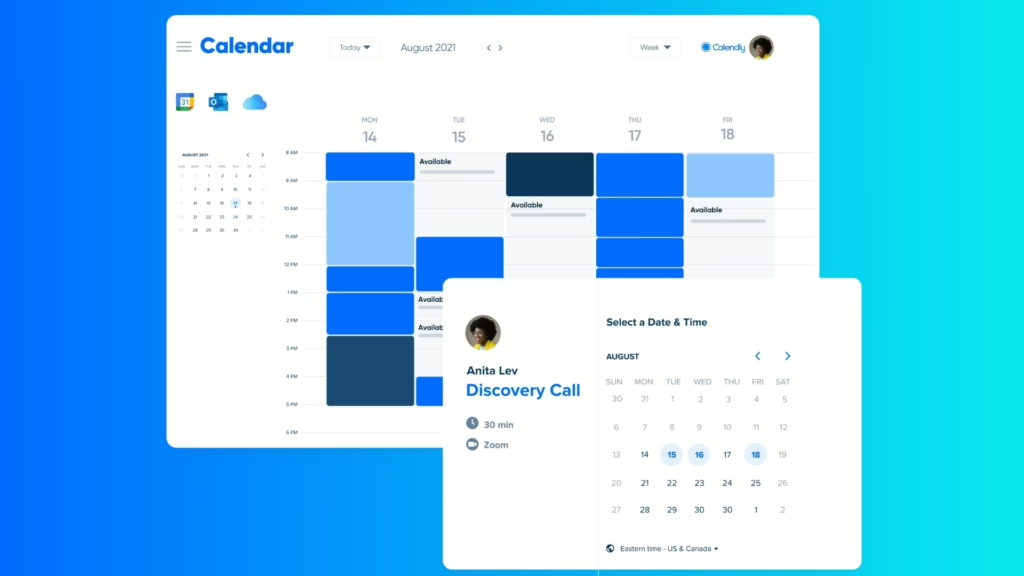
What was Calendly’s Product Led Growth strategy?
- Freemium model: Calendly’s free tier offered real value, encouraging widespread adoption across industries and team sizes.
- User-friendly design: With an intuitive interface and quick onboarding, users could schedule meetings in seconds; no manual, no walkthroughs.
- Viral growth: Scheduling links weren’t just functional, they were invitations to experience the product. Each meeting booked was a built-in referral.
- Enterprise adoption: As more teams and departments used Calendly, organizations naturally expanded their usage. By 2023, 86% of Fortune 500 companies were using Calendly, proving that Product Led Growth can scale from solopreneurs to global enterprises.
Calendly’s journey from a single founder’s frustration to a platform used by millions, shows the compounding power of Product Led Growth. By letting the product speak for itself and building virality into the user experience, Calendly transformed a common scheduling pain into a category-defining solution.
4. Canva: Design for Non-Designers that paved the way for Product Led Growth
Canva didn’t just simplify graphic design, it redefined who could do it. With drag-and-drop ease, a massive template library, and instant publishing tools, Canva made professional design accessible to anyone, anywhere. And it grew not by selling that promise, but by letting users experience it.
Key PLG Moves:
- Free-to-use platform with tiered upgrades
- Drag-and-drop simplicity
- Designs that double as brand exposure
- Viral sharing baked into product usage
But Canva’s journey didn’t start with a pitch deck, it started in a university classroom.
Back in Perth, Australia, Melanie Perkins was teaching students how to use complex design software like Photoshop and InDesign. Again and again, she watched them struggle, not because they lacked creativity, but because the tools weren’t built for them.
That insight led to her first startup: Fusion Books, a tool to help students design yearbooks more easily. It gained traction in Australia, and soon Melanie realized the idea could stretch far beyond the classroom.
In 2013, she launched Canva with a bold vision: “What if anyone could design anything, regardless of skill level?” The key to Canva’s success wasn’t just ease, it was Product Led Growth at its finest.
By making the product free to use with powerful features available right out of the gate, Canva enabled millions of people to create presentations, resumes, posters, social graphics, and more; no training required. Every time a user downloaded or shared a design, they were also spreading Canva’s reach.
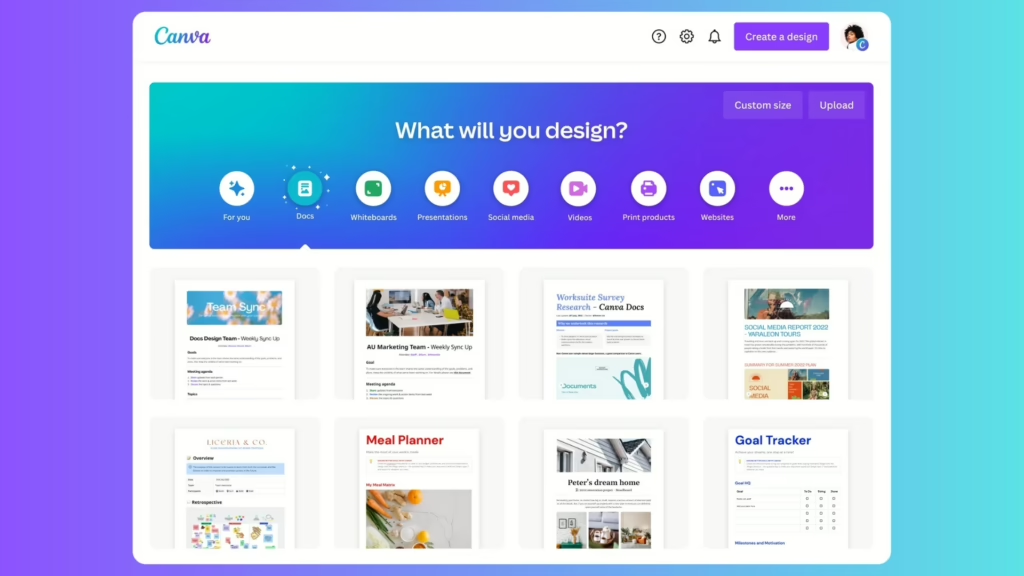
What makes Canva a masterclass in Product Led Growth?
- Freemium access: The core experience was free, allowing anyone to dive in and create without barriers. Premium templates and assets offered a natural upgrade path.
- Drag-and-drop UX: From a student to a nonprofit founder, Canva’s interface was so intuitive that anyone could create something polished in minutes.
- Embedded virality: Designs weren’t just the end product, they were also the distribution channel. Every exported PDF, social post, or presentation had Canva’s DNA in it.
- Community-building: By empowering educators, nonprofits, marketers, and creators, Canva built a passionate user base that drove word-of-mouth growth.
- Massive scale: Today, over 170 million users across 190 countries use Canva, and it’s become the go-to design platform for everyone from startups to Fortune 500s.
Canva’s rise shows what’s possible when your product becomes not just the tool, but the message. With design as both utility and distribution, Canva’s Product Led Growth wasn’t just smart, it was beautiful.
5. Figma: Designing for Collaboration Ultimately towards Product Led Growth
Before Figma, design was often a solo sport. Tools were heavy, downloads were required, and collaboration meant emailing files back and forth or hoping version control didn’t break. Figma changed everything. It brought design into the browser and made collaboration as easy as sharing a link.
Key PLG Moves:
- No-install, browser-based experience
- Multiplayer editing built into the core
- Organic expansion through team invites
- Built-in virality through project sharing
But this wasn’t just about better UX. It was about rethinking how design teams work.
Figma was founded by Dylan Field and Evan Wallace, who believed that design tools should be as collaborative and accessible as Google Docs. At the time, most design software like Adobe Creative Suite was desktop-only, isolated, and expensive. Designers worked alone, then handed off static files to engineers.
Figma set out to change that.
After four years in stealth mode, Figma launched in 2016 with a bold premise: real-time, multiplayer design directly in the browser. No downloads. No versioning headaches. And no gatekeeping between designers, developers, and stakeholders.
It didn’t just win on features, it won on Product Led Growth.
With every new file shared, a teammate joined. With every comment or edit, the product spread. Figma wasn’t just a tool, it was a collaborative space. And that’s what made it unstoppable.
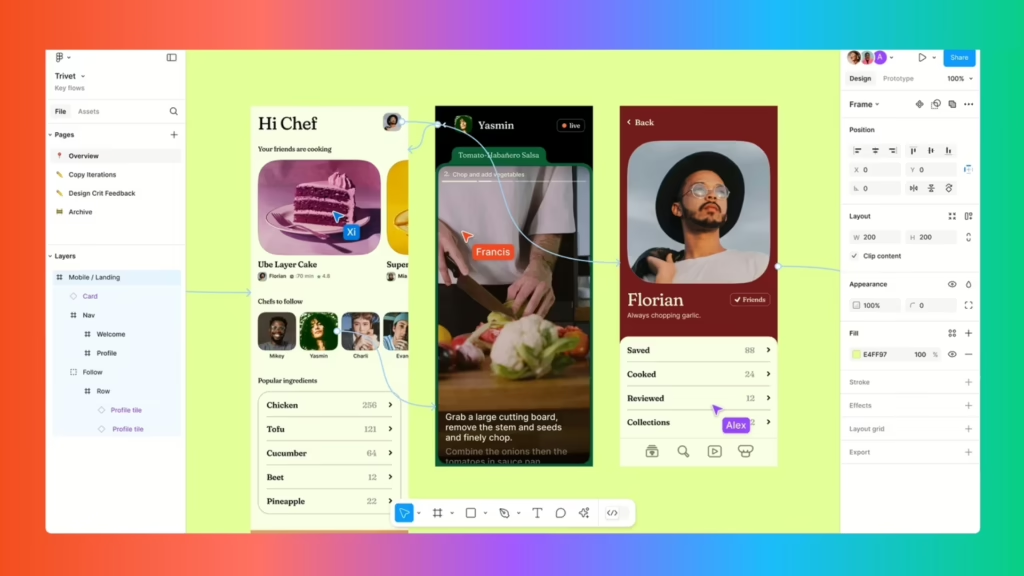
Why Figma’s PLG model worked:
- Instant utility: Anyone could open a browser, start designing, and invite collaborators in seconds, no onboarding friction.
- Multiplayer magic: Figma introduced real-time design edits, comments, and version history, making it a hub for entire product teams.
- Built-in network effects: When a designer used Figma, they had to invite others; engineers, PMs, reviewers who then became users themselves.
- Freemium model: Figma offered generous free tiers for individuals and small teams, lowering adoption barriers.
- Bottom-up momentum: Individual users and small teams started using Figma organically, eventually driving enterprise adoption from the inside out.
By 2022, Figma had become the standard for UI/UX design teams. Figma’s story proves that even complex software can grow robustly, when collaboration is the product.
6. Kannect: Purpose-Built, Community-First, Free – Product Led Growth
Kannect is an all-in-one community engagement and member management platform for nonprofits, universities, and mission-driven communities. It empowers teams to do big things without needing demos, onboarding calls, or a sales push.
Key Product Led Growth Moves:
- Full-featured self-serve onboarding
- Free plan for small nonprofits
- No time limits or locked modules
- Seamless upgrade path when ready
Origin:
Kannect began as Kanexon, a social media platform created by Kailah Romine and Yogesh Kondaskar to support the UN’s 2030 Sustainable Development Goals. It aimed to help nonprofits share impact stories and inspire change. But the founders soon realized social media wasn’t the answer, algorithms and negativity often worked against communities. So they pivoted to build something better: Kannect. A dedicated, collaborative platform for nonprofits and their members to communicate, engage, and grow free from distractions and designed for purpose.
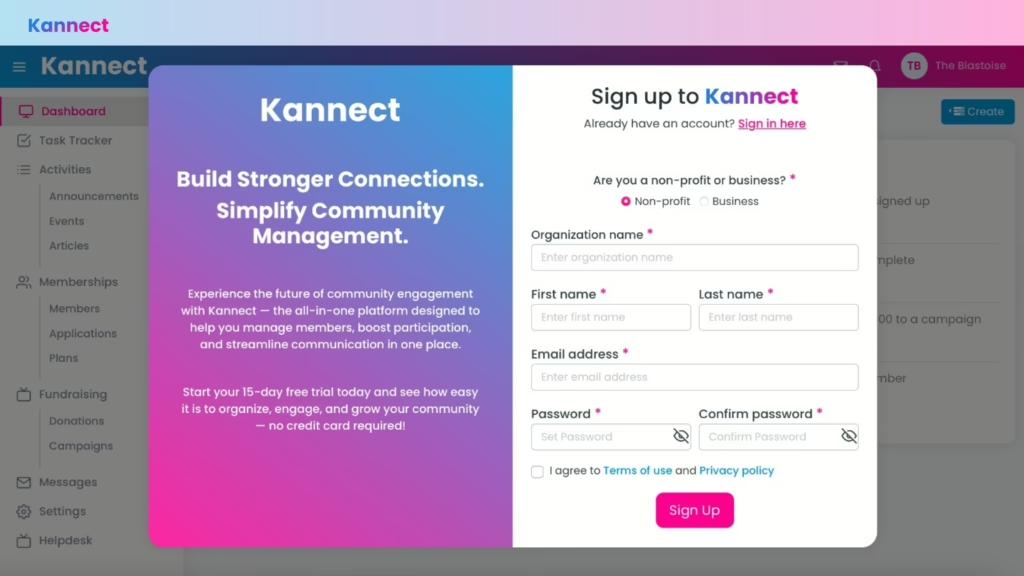
How Kannect Drives Product-Led Growth:
- Free Forever Plan for Impact-Driven Teams: Small nonprofits (under 1000 members) get full access to core features like member management, messaging, donations, content, and events at no cost, fully free.
- No Sales Dependency: New users can sign up, create their org, and go live with campaigns or events in minutes; no waiting, no onboarding calls.
- Built for Momentum: From day one, organizations can add members, launch a campaign, collect donations, send messages, and track tasks, all from a single dashboard.
- Upsell Only When Needed: Larger organizations naturally upgrade when they need advanced features or scale, with no pushy prompts or friction.
- Mission-Aligned Pricing: All paid plans are highly discounted for nonprofits, making Kannect one of the most affordable community platforms available.
Kannect proves that product-led growth works beautifully in the mission economy. When you combine intuitive design with real impact and community trust, users don’t just adopt your product, they advocate for it.
Common Traits of Great Product Led Growth Companies
What do these PLG leaders have in common? More than you might think. Let’s unpack the shared DNA that powers their success.
1. User-Centered Design
From the very first click, the product must feel effortless.
Tools like Slack and Calendly win because users don’t need onboarding videos or long training to get started.
Kannect follows the same philosophy; users can sign up, build an organization, launch a campaign, and start engaging their community in minutes. No demo calls. No delays.
Great PLG products don’t hide their value, they showcase it immediately.
2. Data-Driven Iteration
Every product interaction is a data point.
Dropbox studied which referral paths actually led to signups.
HubSpot (also a PLG pioneer) refined freemium-to-paid journeys using activation data.
Notion rebuild its product based on how users were combining elements.
Kannect listens closely to small nonprofits and mission-driven orgs, improving usability, notifications, and workflows based on how communities actually use the platform.
The PLG feedback loop ensures the product gets better with every user.
3. Built-in Virality
Calendly links. Slack invites. Canva designs. These aren’t just features, they’re growth engines.
Kannect taps into the same dynamic: as users create campaigns, events, and send communications, they naturally invite more members into the platform. Community growth becomes product growth.
In the PLG model, usage drives awareness.
4. Transparent Value and Upgrade Paths
Successful PLG companies don’t hide pricing or restrict exploration.
Canva gives users access to powerful tools for free and clearly communicates what Pro unlocks.
Kannect offers its full platform free for small nonprofits and displays premium features without hiding them behind confusing walls.
There’s no pressure, just clear value. When users are ready to scale, the upgrade path is obvious and trust-based.
The Benefits of Product Led Growth
Let’s break it down:
- Faster adoption (users start immediately)
- Lower customer acquisition cost (CAC)
- Better customer experience (no friction)
- Higher retention (users grow with the product)
- More referrals (happy users bring others)
Simply put, the benefits of product-led growth go beyond revenue, they create a brand people want to use and share. This is why more startups and scaleups are adopting a product led growth model, especially in the SaaS space.
Why Community is the Secret Weapon in Product Led Growth
Here’s something most product teams miss: PLG isn’t just about the product, it’s about the ecosystem around it.
Communities, resource hubs, templates, and help forums turn curious sign-ups into confident power users. They shrink learning curves and build trust faster than any email sequence ever could.
Slack’s user communities help teams discover new workflows. Dropbox‘s early adoption surged through peer-to-peer referral conversations. Figma‘s collaborative forums shape real-time product decisions. Calendly users actively share best practices that inspire others to optimize their scheduling flows. And Canva’s global design community fuels creativity, with user-generated templates spreading awareness of the product.
But when it comes to community-first product-led growth, Kannect stands apart.
Kannect was built for communities; nonprofits, campuses, and teams and its entire product experience reflects that mission. Organizations can create shared spaces, manage members, host wellness check-ins, and share resources without needing to rely on third-party tools or social media algorithms. It’s a space where community management is the product.
This is what makes PLG sustainable, not just scalable. When people don’t just use your product, but use it to build and grow their own communities, that’s the kind of engagement that fuels long-term, mission-driven growth.
Product Led Growth Isn’t Just for Startups
The beauty of Product Led Growth is that it works for teams of all sizes. Whether you’re building a mobile app, launching a nonprofit platform, or managing campus engagement, the principles of PLG apply: deliver value fast, keep things intuitive, and let the product do the heavy lifting.
Kannect Empowers That Vision of Product Led Growth
Platforms like Kannect show that PLG isn’t limited to tech giants. By focusing on usability, mobile-first access, and real-time insights, Kannect helps organizations grow by putting the power in the hands of their users.
You don’t need a sales army. You just need a product that helps people succeed and a platform that gets out of the way.
Ready to experience a product that lets you grow your community?
Product led growth isn’t just a strategy, it’s a mindset. And at Kannect, we’ve built a platform that puts community organizations in control from day one.
If you’re a nonprofit, university, or mission-driven team looking for a smarter way to engage, communicate, and grow; you don’t need wait longer. You just need to start!
💡 Start your free account at Kannect today or book a demo to explore how Kannect supports nonprofits and teams get more done effortlessly, together.
Would you like to see how Kannect works first? Watch this 90-second walkthrough!
✔️ Follow us on LinkedIn for more tools and tips that make task management easier and more human.
✔️ Subscribe to The Community Engagement Playbook – one smart, actionable read delivered weekly to your inbox.
Try Kannect today
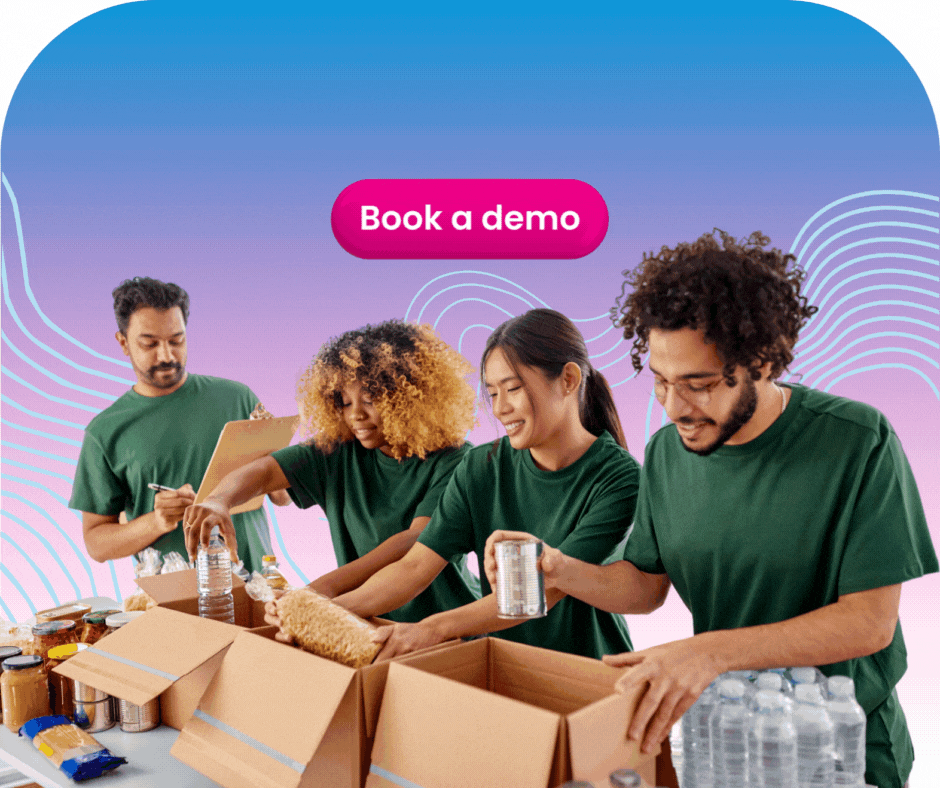
what the heck is product led growth, product-led growth metrics, product-led growth strategies, product led growth business, product led growth metrics
FAQs: All about Product Led Growth
1. What does Product Led Growth mean in simple terms?
It’s a growth strategy where users experience the product before buying. The product drives adoption, upgrades, and referrals, all by delivering value upfront.
2. How is Product Led Growth different from sales-led?
In sales-led growth, a rep walks the buyer through a pitch. In PLG, the user tries the product, sees value, and decides to upgrade, often with no salesperson involved.
3. Can nonprofits or communities use Product Led Growth?
Absolutely. As long as users can experience the platform’s value easily, PLG works. For example, nonprofits using Kannect can start organizing and fundraising in minutes, no demos required.
4. How does Kannect support Product Led Growth?
Kannect offers a fully self-serve setup, intuitive design, and immediate functionality, perfect for organizations that want to engage communities without learning curves.
5. Is Kannect a product-led platform?
Yes. Kannect is built around the PLG mindset, empowering users to get started quickly, engage deeply, and grow naturally through value, not friction.

